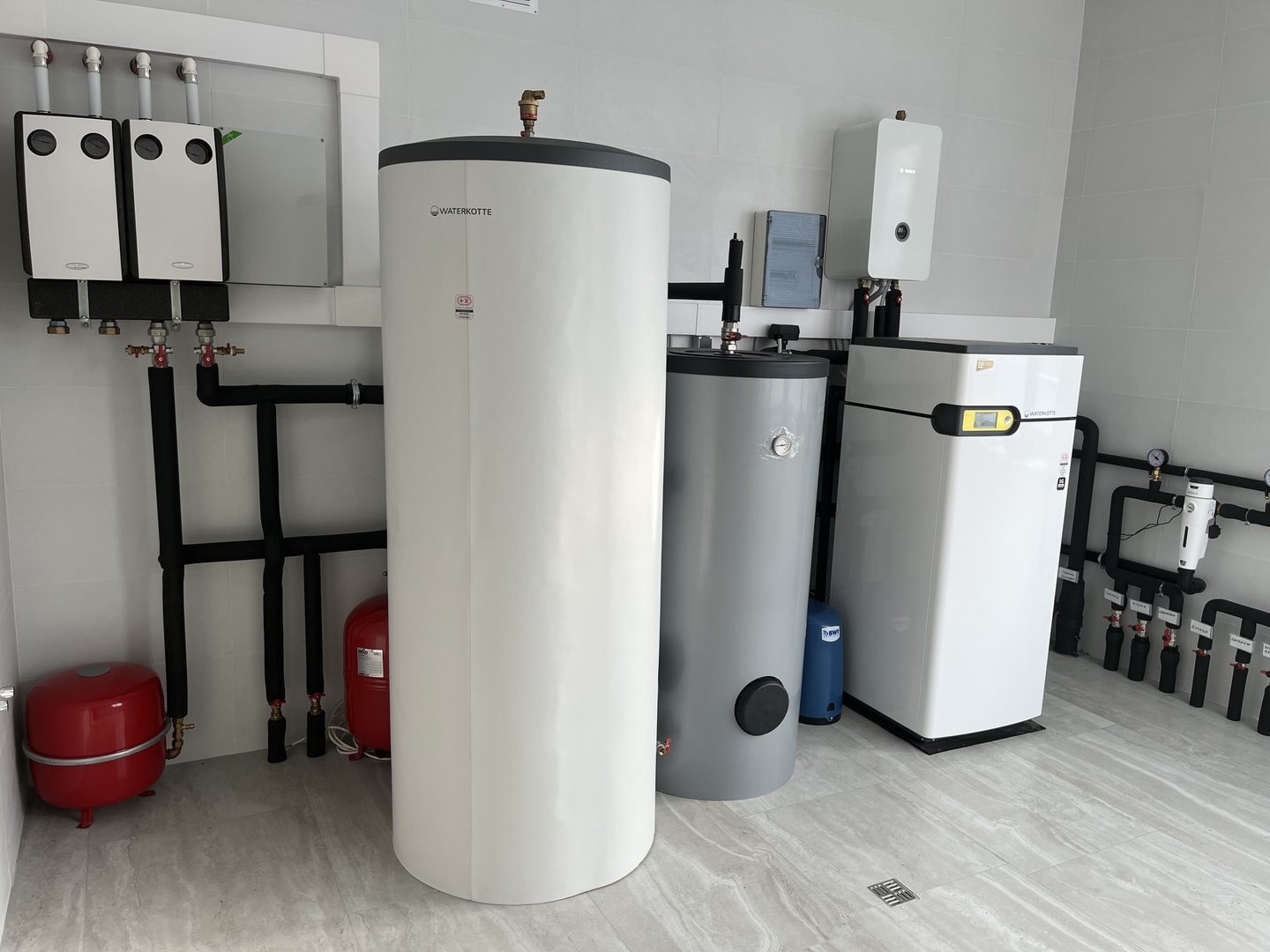The issue of prolonged power outages is more relevant than ever, so it is essential to prepare for the heating season now. Ensuring uninterrupted heating supply in buildings has become critically important. One innovative solution in this area is the use of heat pump heating units. This article explains how such systems function during blackouts and how they can provide reliable heating even in challenging conditions.
What is a Heat Pump and a Heat Pump Heating Unit?
A heat pump is a device that uses a small amount of electrical energy to transfer thermal energy from one place to another. It utilizes the refrigeration cycle principle, which can use heat from the environment (air, water, ground) and transfer it to the interior space of a building for heating.
Components of a Heat Pump Heating Unit
- Heat Pump — the primary device that generates heat.
- Buffer Tank — stores hot water to ensure stable heating supply.
- Backup Heat Source — can be a gas or pellet boiler.
- Automation System — controls the operation of the pump and other system components, coordinating them according to your preferences.

Fig. 1 Heat Pump Hajster Nebo + Combined Tank (Buffer and Boiler)

Fig. 2 Heat Pump Hajster Nebo + Buffer Tank + Instantaneous Water Heating Station
How Much Electricity Does a Heat Pump Consume?
The amount of electricity consumed by a heat pump depends on several factors, such as the type of heat pump, its capacity, efficiency (COP - coefficient of performance), climate conditions, and area size.
For example, consider a heat pump with a COP of 3 and a heating capacity of 10 kW, operating 10 hours a day:
- Electric power consumption = heat pump capacity / COP
- Electricity consumption per hour = 10 kW / 3 = 3.33 kWh
- Electricity consumption per day = 3.33 kWh * 10 hours = 33.3 kWh
Thus, this heat pump will consume approximately 33.3 kWh of electricity per day.
What is the Electricity Tariff if the Heating Unit Operates on a Heat Pump?
Starting from June 1, changes have been made for individual and collective household consumers living in residential buildings (including hotel-type residential buildings, apartments) equipped with electric heating installations such as heat pumps or electric boilers:
- up to 2000 kWh consumed per month - 2.64 UAH/kWh
- over 2000 kWh per month - 4.32 UAH/kWh
Problems with the Operation of the Heating Unit During Blackouts
During blackouts, the main problem is ensuring power supply for the operation of the heat pump and the control system. Without electricity, the heat pump cannot function, which can lead to a cessation of heating supply and, consequently, cooling of the building.
Solutions to Ensure Uninterrupted Operation of the Heating Unit During Power Outages
Batteries
Using batteries to provide backup power is one of the most effective ways to ensure the operation of the heat pump during blackouts. Such batteries can power the pump and control system for several hours or even days, depending on their capacity. However, the higher the capacity of your heat pump, the more batteries you will need.
Generator
A heat pump can operate from a generator, but to ensure its proper operation, several important factors must be considered. This includes calculating the generator's capacity, considering peak loads, the type of fuel for the generator, and setting up the system for uninterrupted operation.
Solar Panels
Integrating solar panels with the heat pump system allows for an additional source of electricity, which can be used both for charging batteries and for directly powering the heat pump.
Hybrid Systems
Combining heat pumps with traditional heat sources (gas or solid fuel boilers) can provide backup heating in case of prolonged blackouts.
Intelligent Control Systems
Using modern control systems that can automatically switch to backup power sources and optimize energy consumption helps reduce the risks associated with power outages.

Fig. 3 Operation of the Heating Unit on a Heat Pump from a Generator
- The generator provides electricity during power outages. The generator is connected via an Automatic Transfer Switch (ATS).
- The power grid is the primary power source for the heat pump. When electricity is unavailable, the generator becomes the main power source.
- The ATS automatically switches the power source from the power grid to the generator in case of a power outage.
- The heat pump uses electricity for operation, regardless of whether it is from the power grid or the generator.
- The buffer tank stores the heat produced by the heat pump.
- The heating system (radiators, underfloor heating) receives heat from the buffer tank to heat the premises.
- Arrows on the diagram show the flow of electricity and heat between the system components.
Are There Compensation Programs for Installing Heat Pumps in Ukraine?
Starting from May 7, 2024, homeowners associations (HOAs) and housing construction cooperatives (HCCs) have received funding opportunities for the installation of alternative heating and energy sources, such as:
- Installing heat pumps, including air-source heat pumps, geothermal heat pumps, and water-source heat pumps.
- Installing heat pumps will ensure heating and hot water supply for the building.
- Installing solar power plants (SPPs), according to technical requirements.
More about the GreenHome program

Heat pump heating units are an efficient and environmentally friendly solution for heating buildings. However, during blackouts, additional measures must be taken to ensure their uninterrupted operation. Using batteries, solar panels, hybrid systems, and generators can reduce risks and ensure stable heating supply even in the most challenging conditions.
